| December 6, 2004 |
The last time I went to a geosynthetics conference in India I had to take a side trip to Kathmandu to get a visa (see article in GFR April 1998). Now I have just arrived in Bombay to attend and present three papers at ICGGE-2004, but this time I had a visa – it makes entry so much easier! I’ll be trying to keep geosynthetica.net informed in real-time of happenings at the conference. And if anyone wants information on what is happening with geosynthetics in India please email me at icorp@geosynthetic.com and I will try to find out. I leave at midnight Friday/Saturday.
Check out the papers being presented at http://www.civil.iitb.ac.in/~icgge/icgge-abstract.xls. I notice few papers on geomembranes but several on geotextiles and geogrids. Of course, there are many on jute and coir. Needlepunched geotextile manufacturing machine special features. Fiber reinforcement of pavement subgrades and behind retaining walls. Textile composites in sound barriers. Light weight material applications. EPS and tire chips behind retaining structures. Effect of rigid facing on seismic performance of reinforced earth walls. Sixteen year performance review of Paraweb walls. Aramid composite friction tie in retaining walls. Geocontainers on rigid and deformable foundations. Erosion control in high speed Himalayan river. Review of geogrid failures using PLAXIS.
Keep checking in, I’ll be back tomorrow.
India – the cows wander the roads and shanty towns exist. There are millions of people, autorickshaws, and taxis.
 |
|
The Gate of India
|
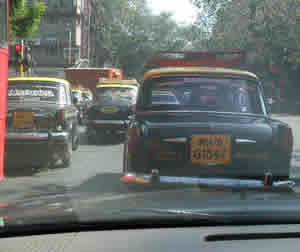 |
|
The busy streets of Mumbai
|
 |
|
On the way to the conference
|
ICCGE-2004 is about to start, and geosynthetica.net mouse pads are in the registration kit. The exhibition is in the open air!! About 350 people are expected. The cars, rickshaws, bikes, and cars in the streets of Mumbai are stacked up just like the files in Prof. Mandal’s office!
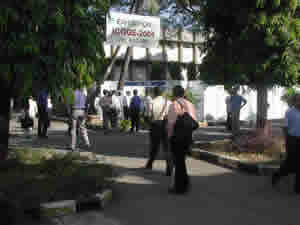 |
|
|
Open air exhibit!
|
|
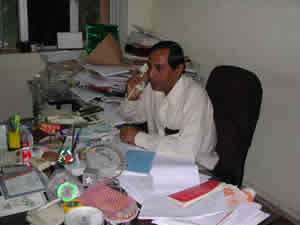 |
|
|
Professor Mandal amid the stacks
|
The Gate of India has been more open than ever. The first news we hear is that Strata is about to start manufacturing geogrids in India. Check in later for another daily update!
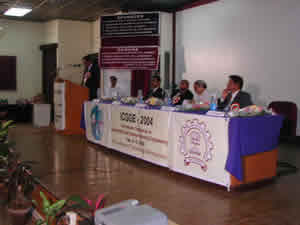 |
|
Opening Ceremonies
|
A plea from one of the opening ceremony speakers (an academician) was that theoreticians and practitioners should interact more. A response by a practitioner later was "it will never happen!" But I am not sure that we have not started on the way to doing that through the NAGS 03 conference with the Canadian Geotechnical Society, and Geo 05 and GRI-18 with the Geo-Institute’s GeoFrontiers.
Prof. Indraratna (Australia) discussed sideways confinement of railtrack ballast using a geogrid to prevent break up of aggregate and loss of ballast support. There are tremendous differences in tensile stresses in ballast between simple static loading and dynamic loading of high-speed heavy trains. The grid enables recycled ballast to achieve the same performance as new ballast. Prof. Patrick Naughton (Ireland) described a new Paragrid shaped to hold a geotextile in a channel along the ribs to allow adequate drainage of water from retaining wall backfill soil during construction – pull out strength increases rapidly as water is removed.
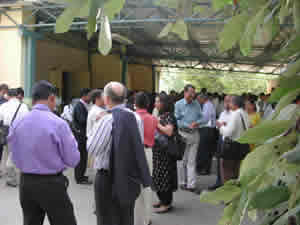 |
|
A tea break between papers
|
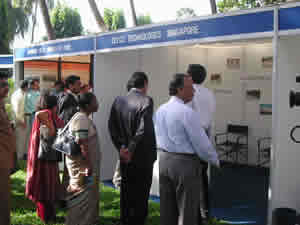 |
| Official party at the CETCO (Singapore) exhibit |
Prof. Madhav (India) presented a neat theory allowing for a vertical component of pullout stress rather than just straight pull out strengths, considering the downward movement of a grid as it crosses the rotational failure plane behind a wall. This was demonstrated by placing a few books on a sheet of paper overhanging the edge of a table. Pull the sheet straight and it moves easily, but pull it with a downward component over the edge of the table – it is much harder to move. Prof G. V. Rao (India) presented information on the reinforcing effect of tire chips of different sizes and aspect ratios in sand as a means to save sand and to dispose of tires. While strengthening increased with size and aspect ratio (max 2:1 used) limitations on the size of the equipment probably prevented higher aspect ratios generating a more significant increase in strength. Dr. Tiyagi (India) proposed the use of a compressible layer (geofoam) behind a retaining wall to absorb the compressive stresses caused by soil moving behind the wall, so as not to impact the facing. Significant discussion ensued. I discussed performing electrical leak location/integrity surveys on double liners with a nonconductive geonet leak detection layer, comparing backfilling with water or the use of a conductive geotextile.
 |
|
Professors Choudury (IIT Bombay) and Mandal (IIT Bombay)
|
Other news: GCLs have been installed in only two projects in India, but more are planned. To follow a journal "Everything About Water" in January 2005 there will be "Everything About Soil Improvement" with bi-monthly themes on geosynthetics (Jan/ Feb), ground stabilization (Mar/Apr), erosion control (May/June), landfills (July/Aug), and retaining walls (Sep/Oct). Stay tuned for tomorrow’s report!
Prof. Kamon presented a Keynote lecture on Japan’s new three component liner (PVC/Polyurethane/PVC) primarily used in vertical cut-off walls. Development thickness is 30 mm with a production target of 20 mm. The gap between two PVC geomembranes with spacers is filled with pumpe
d-in PUR. PE is not used due to the difficulty of getting a bond with the PUR. Prof G.V. Rao presented another sand strengthening paper this time using waste plastic strips. Another paper on using compressible EPS foam behind a retaining wall face then a drainage layer of tire chips was described by Dr Hazarika (Japan). And Prof. Shin (Korea) described three soft soil improvement projects (including the new Incheon airport) with emphasis on the performance of prefabricated vertical drains.
There were also a few sponsor/donor company outline presentations which, as a visitor, I found quite interesting and useful – they gave me an idea who I should be talking to, and provided an opening topic. This reminds me of another interesting event at the recent Construction Risk Management conference that geosynthetica.net attended – a lunch in which about 40 of the tables were set up with a specific technical topic of discussion led by an expert in that field.
TechFab is about to start manufacturing the first geogrid in India – knitted PET yarns coated with PVC. Naue (a gsa Underwriter) recently installed a second Secugrid line. A novel geomembrane joint was recently seen in south east Asia – overlapped HDPE rolls (no weld) with split bamboo stalks clamped on either side of the joint with loops stitched through the geomembrane approximately every meter. No need to do a leak survey on that one! Z-Tech is about to start including electrical liner integrity surveys in their liner installation QC procedures.
The banquet was held outside at a new hotel with much appreciated traditional music and dancing – right underneath an impressive green retaining wall!
| Pictures of day two of the ICGGE 2004 conference – names omitted to protect the innocent, and because I can’t remember them all, so I won’t mention any! | 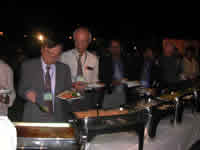 |
|
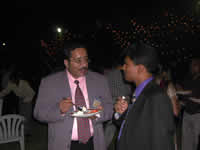 |
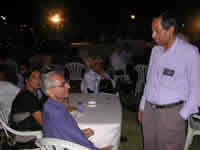 |
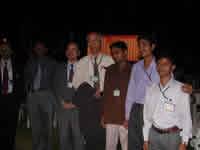 |
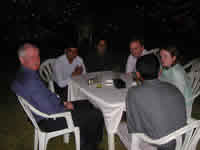 |
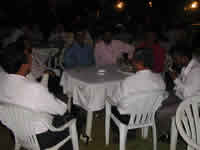 |
 |
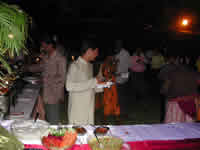 |
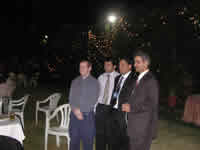 |
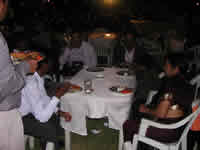 |
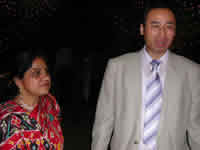 |
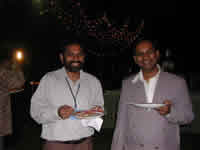 |
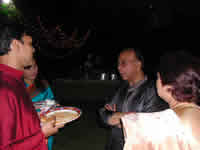 |
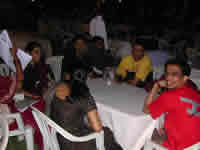 |
 |
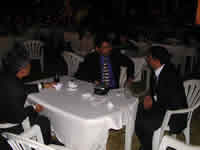 |
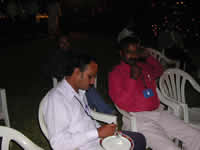 |
 |
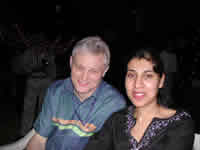 |
Last day of the conference. The first keynote lecture by Prof. Leung (Singapore) presented an overview of scaling factors required for successful centrifuge experiments/modeling – time being one of the more important. Soil dynamic and consolidation scales are different which requires the use of silicone oil instead of water to normalize them to get correct pore pressures in soil. Nor is it possible to use the actual geosynthetic since it acts as a "giant geosynthetic," so an appropriate thin cloth is required. Miniature transducers must also be used so they do not unduly influence the process phenomena. As I was thinking about the need to reduce the soil particle size to match the characteristics of the "thin cloth" to achieve appropriate interface shear strengths in the model Prof. Indararatna (Australia) raised his concern about how meaningful friction angles were assured.
Prof G.V. Rao gave a keynote lecture reviewing GCLs, which appear to be on the verge of much increased use in India. A new GCL has been patented. There is much encouragement to establish a manufacturer in India to minimize transportation costs and to take advantage of Indian sources of bentonite.
The third keynote lecture of the day was an overview of Geotubes® by Shobha Bhatia (USA) particularly for erosion control and dewatering. Dr. Tyagi (India) discussed geocontainers on rigid or deformable containers.
The proceedings became suitably lively when Mr. Venkataraman (India) made his presentation on the use of HDPE and steel rope nets to contain falling rocks in steep railroad cuttings (clearly a successful application since serious rock fall incidents had been reduced by about 90% since the nets were first installed). However, Prof. Katti (India) was quite adamant that it was necessary to fully understand the associated theories before putting such systems into place (falling rock sizes, rock properties, sizes/depths of periodic fasteners, likely impact of fasteners on rock stability, etc.). The discussion became increasingly heated and more polarized (theory vs. practice – remember the request for discussions in the opening ceremony!?) until Prof. Chandrasekaran (India) did some very effective mediation. He gave the example that if there is a 10% chance of a rockfall and a 10% chance of retaining net failure, the chance of a serious incident has been reduced to 1% – a significant improvement and one that has been shown practically to occur. Thus the practical approach, without extensive analysis, is acceptable. He received a round of applause! I was asked to say a few words in the closing ceremony and commented that I would take home the memory of this theory/practice divide, but that it could be bridged – the conference itself would have contributed to that, but it certainly will not happen overnight. Of course, both sides are correct but they must somehow be integrated for optimum benefit to our industry. New technologies are first practiced (with varying degrees of success) which defines the need for analysis and theoretical understanding, then the developed models require further practice to prove whether or not the models are correct. Clearly, there is a need for both approaches. In the same way, a composite liner performs much better than either a mineral liner or geomembrane liner alone.
In the closing ceremony Prof. Katti made an interesting proposal that, with the significant introduction of geosynthetics into geotechnical and civil engineering, geotechnical engineering, parts of civil engineering, and geosynthetics should be integrated under the materials engineering banner.
General observations? Several presenters used video clips to good effect. On the other hand, there was still some excessive use of distracting flying-in transitions to new slides. Slides with too much unreadable data. Forty slides in 10 minutes are too many! And despite the pleas of organizers to turn off cell phones, they still rang – and in some cases were even answered with extensive conversations!
There were over 300 registrants from many countries at this very successful conference. Prof. Venkatachalam (Conference Chairman) suggested that Prof Mandal and Dr. Choudhury immediately start work on another conference. They were not to keen to do so! The attendance at this conference shows the keen interest in geosynthetics in India.
Then finally, after being driven for four days as if on the path of a dipsy-doodling fiber in a nonwoven geotextile, it had to happen…dri
ving to the airport, our taxi got a bumper-size gouge along one side by another car. More heated discussion, with much waving of arms, while cars, buses, auto rickshaws (thousands of them), and lumbering trucks (no cows this time though) passed us on four sides. Money changed hands and we were on the way and doing routine battle again!
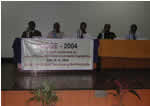 |
 |
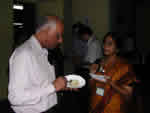 |
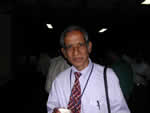 |
 |
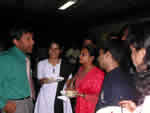 |
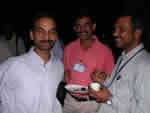 |
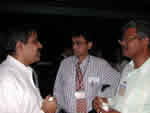 |
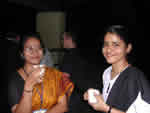 |
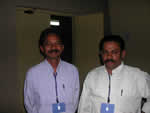 |
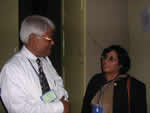 |
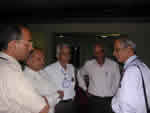 |
A great conference, great people, great friends, and a great future. And it did not rain once on the exhibition!











